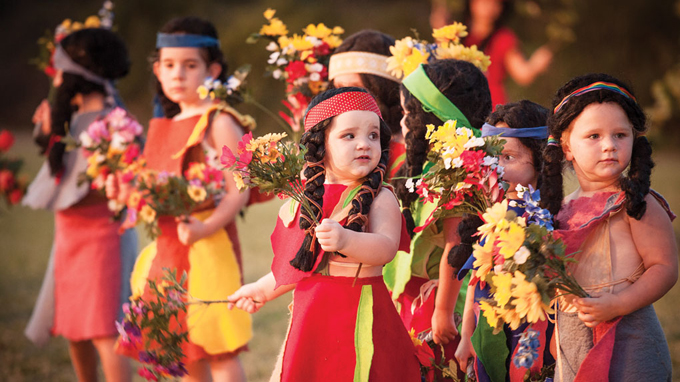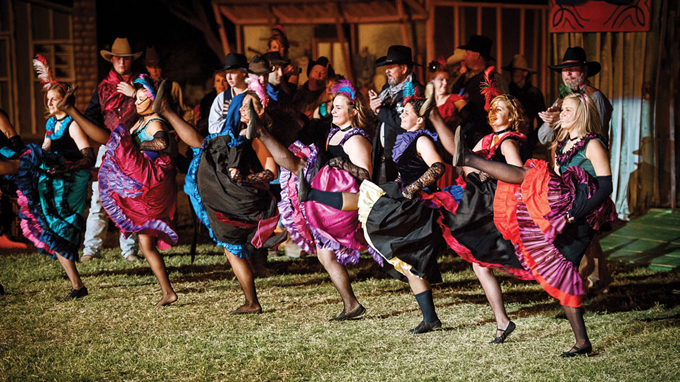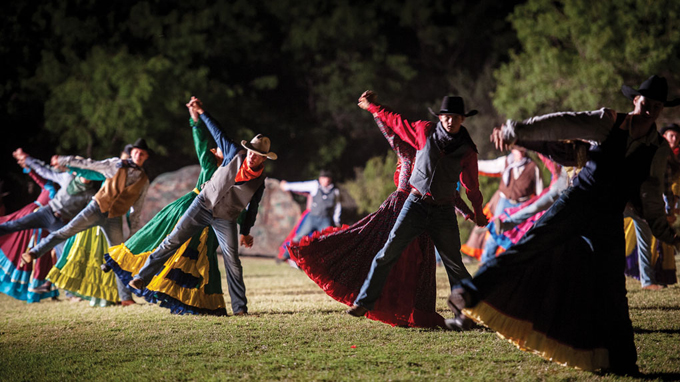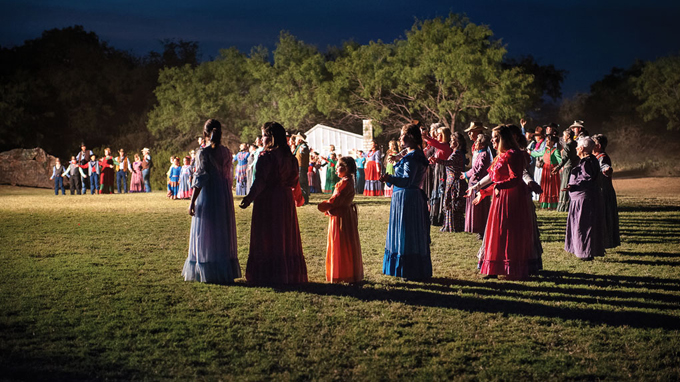Here come the riders, stampeding out from behind a thicket of mesquite trees, drowning out the music and cheers from the stands and kicking up a curtain of dust that rises over the crowd. The Fort Griffin Fandangle has begun. More than 1,700 people are packed into the grandstand, which is built into a hillside that overlooks the stage, a small prairie surrounded by outcrops, scrub oaks, and mesquites. It is dusk, and a narrator’s voice comes over the loudspeakers. “This is not a chronicle but instead a show. History not as it comes from books but the history in the minds of old-timers, not separated from the hearts of the men who lived it.”
 Lanham Martin, one of the riders who open the show with a high-speed Flag Parade.
Lanham Martin, one of the riders who open the show with a high-speed Flag Parade.
The history is a rough and bloody one. Fort Griffin was founded in 1867 as a bulwark on the violent and dangerous frontier. In 1874 soldiers from the fort launched the Red River War, a brutal campaign against the Southern Plains Indians that ended the following year when the famous Comanche chief Quanah Parker surrendered.
Fort Griffin’s notoriety was not limited to the military sphere. Below it on the prairie was an area known as the Flat, a lawless neighborhood infamous for the entertainments it provided the soldiers, hunters, trail drivers, and outlaws who congregated there. Doc Holliday and Wyatt Earp first met in the Flat, and Cormac McCarthy chose to end his western masterpiece Blood Meridian in an outhouse behind the Beehive Saloon, a local watering hole. In 1881 the fort shut down, and by then buffalo hunters had killed off what was left of the great herds and bone collectors had picked through the remains. The Flat had lost its purpose. When the railroad came through later that year it bypassed the area altogether for nearby Albany.
Some sixty years later, the Fandangle was born. Its creator, Robert Nail, was a promising young playwright from Albany who had attended Princeton University and studied under Thornton Wilder. Nail dreamed of moving to New York, but after his father’s suicide, in 1932, he took a job teaching English at the local high school. A few years later, to help raise money for a senior class trip, he decided to put on a play. Nail called his show Dr. Shackelford’s Paradise; it was performed on the football field. The reception was so great that the cast expanded to include townspeople, and the name was changed to the Fort Griffin Fandangle. It has been performed nearly every summer since, making it the oldest outdoor musical in Texas. (The narrative is the same every year, but some of the songs change.) Nail once described it as “a dramatic interpretation of ourselves on our home ground.”
 Cast members perform “Dugout,” a song about making a home on the frontier.
Cast members perform “Dugout,” a song about making a home on the frontier.
The sky tonight is pitch-black by the time a local rancher named Clifford Teinert takes the stage. At 74, he’s nearly as old as the show and has ranched in the area his entire life. (Teinert and his wife actually own the property that used to be the Flat.) He has tufts of white hair under his cowboy hat and a thick white mustache and does not look like a man who enjoys musical theater. He lifts his microphone and sings “Ol’ Timer,” the number that kicks off the first act. The show proceeds with little girls dressed as prairie flowers, catclaw, and cottonwood trees and little boys dressed as prairie dogs, jackrabbits, and wolves. In ten years the girls will have graduated to playing saloon ladies and cancan dancers, and the boys will have become cowboys and Comanches.
 Boys get dressed as animals for the “Indian Prairie”
Boys get dressed as animals for the “Indian Prairie”

Girls dressed for the “Indian Prairie”

Cancan dancers outside the Beehive Saloon

Teengers perform “Huppi Hi”
The people who perform the Fandangle—about four hundred in this year’s show—are required to live in Shackelford County, own land there, or have some kind of familial connection to the place. The artistic director, Betsy Black Parsons, started working for Nail in the sixth grade, folding programs for the show. She worked her way up to designing costumes and painting sets and eventually assisting the longtime director Marge Bray, a woman who ran a dance studio in Albany. On the afternoon that Bray, who was dying of cancer, was brought home from the hospital near the end of her life, she asked Parsons to take over the show. Twenty years later, Parsons is still directing it.
 Artistic Director Betsy Black Parsons leads the cast in dress rehearsal.
Artistic Director Betsy Black Parsons leads the cast in dress rehearsal.
“We’ve become ‘interwoven,’ ” she says. “That’s the word we use around here, that we’re all interwoven with the show and each other.”
Underneath the sweet and sentimental showtunes, the Fandangle tells a story of cruelty and pain. There are Indian raids and kidnapped children, women who do little but cook supper and have babies and despise their husbands; the prairie families are surrounded by suffocating darkness “that makes the land more strange.” The narrative is sanitized considerably, but the shadow of the past remains. About an hour in, a twelve-year-old boy named Braden Davis sings a ballad about a cowboy who is fatally injured when his horse falls. When Braden gets to the part about the blood running down the cowboy’s face, the little girls around him yell, “Drip! Drip! Drip!” When the blood pools around the dying cowboy, the girls come in again: “Splash! Splash! Splash!”
The crowd roars with applause and laughter. After a square-dancing number, an Indian raid finishes the first half of the show. The lights dim and the crowd waits in darkness as the crew prepares for the second half, which will tell the story of Fort Griffin and the Flat and the town’s more recent history. Jim Law, a longtime performer who owns a propane business in Albany, tows the towering wooden facades of saloons and hotels into place with his Jeep. Minutes later, soldiers belt out verses about the frontier cavalry. “Find a girl, drink up, you never know when you’ll be scalped by an Indian . . .” Law’s part is coming up. Just before the Fandangle gets to the story of the Beehive Saloon, he’ll walk out from behind the set to sing the final verse of “Drunk and Disorderly.” In anticipation, he takes a nip of Hot Damn, cinnamon-flavored schnapps that helps to lubricate his vocal cords.
The show ends with another piece of narration from the loudspeakers, a tribute to the courthouse clock that shines to the south of the stage and “kept time for the fathers and grandfathers and haunts the memories of old-timers.” After the crowds have cleared, a few of the performers and musicians and members of the oldest Albany families gather out in the parking lot. They grab beers out of ice chests and tell stories, some about the Fandangle, some not, while the laughter of teenagers doing the same echoes in the distance.
 Cast members sing “Going to Texas/Lock, Stock and Barrel,” a tale of packing up everything and heading west.
Cast members sing “Going to Texas/Lock, Stock and Barrel,” a tale of packing up everything and heading west.







